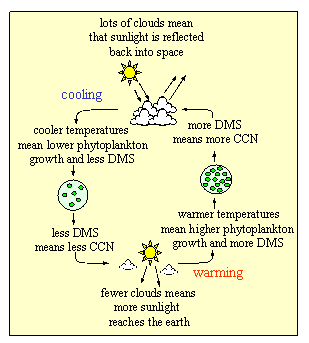|
|
 |
|
|
|
 |
| |
|
|
 |
The Oceans
Read more |
GAIA - The Greek Goddess of the Earth
In the 1960's the scientist Jim Lovelock suggested that all living matter on Earth acts together to keep our planet a fit place for life. He, and his co-worker Lynn Margulis, proposed that the Earth has the ability to react to changes in conditions in such a way as to correct itself and keep conditions on Earth suitable for life. Lovelock named this control system, Gaia, after the Greek Goddess of the Earth.
|
|
|
|
|
 |
Is there evidence for this whole Earth control system?
The CLAW Hypothesis
R. Charlson, J. Lovelock, M. Andreae and S. Warren (1987). Oceanic phytoplankton, atmospheric sulphur, cloud albedo and climate. Nature, 326, 655-661.
In 1987, Robert Charlson and his colleagues suggested that phytoplankton don't just simply affect climate by producing the gas dimethyl sulphide (DMS) but actually play a role in regulating the climate of the Earth. The CLAW hypothesis (named after the authors of the paper) says that if a change in the temperature of the Earth occurs, for example due to global warming, phytoplankton respond to reduce this change. The authors idea was that if temperature increases, phytoplankton will grow more and produce more DMS. The increase in DMS concentrations would subsequently lead to an increase in the amounts of sulphate aerosol in the atmosphere and these aerosols would both directly and indirectly cool the planet, reducing the initial temperature rise.
The CLAW hypothesis is an example of a negative feedback loop where some mechanism acts to counteract the initial change in such a way to maintain the status quo. Positive feedback occurs when the initial change is amplified by subsequent processes.
|
 |
 |
|
1. A simplified representation of the CLAW Hypothesis, an example of a negative climate feedback loop. DMS stands for dimethyl sulphide and CCN for cloud condensation nuclei. Author: Lucinda Spokes.
|
Do we have evidence to confirm the CLAW Hypothesis?
All scientific studies conducted so far show that sulphate aerosols are important in climate control and models suggest that they do cause cooling. Ice cores, which give a record of the Earth's past, show that sulphate aerosol levels in the atmosphere have changed in phase with climate cycles over glacial and interglacial time scales. Recent studies have also shown that there is a link between DMS emissions and the number of cloud condensation nuclei (CCN) present in the atmosphere and that increases in the temperature of surface seawater do lead to increases in DMS concentrations in the air.
So we now have evidence that some of the steps within the CLAW hypothesis are correct but we still don't know whether the system really operates as a negative feedback loop. This makes it very difficult to represent the process in climate models and so we are still unsure quite how important DMS is to the cooling of our planet.
About this page:
author: Dr. Lucinda Spokes - Environmental Sciences, University of East Anglia, Norwich - U.K.
scientific reviewer: Dr. Sue Turner - Environmental Sciences, University of East Anglia, Norwich - U.K.
last updated: 2003-10-02
|
|
 |
|







